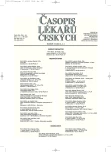The fate of a model of Pathological Anatomy Institute of Medical Faculty in Prague
Authors:
Ludmila Hlaváčková
Authors‘ workplace:
Univerzita Karlova v Praze, 1. lékařská fakulta , Ústav dějin lékařství a cizích jazyků
Published in:
Čas. Lék. čes. 2012; 151: 211-213
Category:
History of Medicine
Overview
In the former Pathological Anatomy Institute of the German Medical Faculty in Prague (U Nemocnice 4) a rare model of this building, made in 1861 for the World Exhibition in London has been preserved. The model was finally not sent to the London exhibition. Documents illuminating the fate of this valuable monument found in the National Archive. Thanks to the department head emeritus PhDr.. A. Malečková and her successor Ph.Dr. H. Skálová this model was professionally restored by Mr. Antonín Hruška in 2010.
Key words:
Pathological-Anatomical Institute in Prague, working model, the World Exhibition in London.
Sources
1. Národní archiv (dále NA), fond ČM 1856–1883, kart. 1735, 34/5/2 : 15. Plány jsem dosud nenalezla. Stavbu vedl vrchní inženýr Turner a ing. Boleschka, stavbyvedoucí byl Josef Čermák.
Dobiáš J, Marek J. Dr. Václav Treitz 1819–1872. Čas Lék čes 1983; 122 : 405–407.
Hlaváčková L, Svobodný P, Bříza J. Dějiny Všeobecné fakultní nemocnice v Praze 1790–2010. Praha: Maxdorf 2011; 55.
2. Die Deutsche Karl-Ferdinands - Universität in Prag. Prag: Verlag J. G. Calveschen K.u.K. Hof Universitätsbuchhandlung Josef Koch 1899; 221.
3. Hamperl H. Werdegang und Lebensweg eines Patologen. Stuttgart – New York 1972: F.K. Schattauer Verlag; 192. Za laskavé upozornění na tuto publikaci děkuji kol. Doc. PhDr. P. Svobodnému, Ph.D.
4. NA ČM 1856–1883, kniha č. 551, 24/5/1.
5. Halada J, Hlavačka M. Světové výstavy od Londýna 1851 po Hannover 2000. Praha: Libri 2000; 14.
6. Kučera J. Konservativní poučení z revoluce. Politická kariéra J. A. Helferta. Národní dějiny 2006; 14 : 309–321.
7. Arenstein J. Oesterreich auf der internacionalen Ausstellung 1862. Im Auftrag des k.k. Ministerium für Handel und Volkswirtschaft. Wien: K.K. Hof - und Staatsdruckerei 1862.
8. NA ČM 1856–1883, kart. 1847, 37/2/46. Koncept přípisu z 21. 12. 1861.
9. Tamtéž, přípis z 24. 12. 1861.
10. Ottův slovník naučný sv. 20. Praha: Vydavatel a nakladatel J. Otto 1903; 233. V textu je Popp nazýván německým termínem francouzského původu „Modelleur“. Domnívám se, že zmíněná šifra „Pp“ na boční stěně modelu je jeho šifra.
11. viz poznámku 8, telegramy z 21. 1. 1862.
12. NA ČM 1856–1883, kart. 1847, 37/2/46, Vídeň 7. 5. 1862.
13. Kolega PhDr. J. Kahuda, PhD. z Národního archivu se obrátil s dotazem na příčinu zamítavého rozhodnutí komise o poslání modelu do Londýna na pracovníka vídeňského Všeobecného správního archivu Dr. Huttera. Ani on nenalezl dokumenty k objasnění této otázky. Oběma kolegům za jejich laskavou pomoc děkuji.
14. viz poznámku 7, s. 64 a 94. Čas Lék čes 1862; 1 : 191.
15. viz poznámku 2, s. 221. Na restaurovaném modelu je nápis poněkud pozměněn – místo Anatomicis je Medicis.
Labels
Addictology Allergology and clinical immunology Angiology Audiology Clinical biochemistry Dermatology & STDs Paediatric gastroenterology Paediatric surgery Paediatric cardiology Paediatric neurology Paediatric ENT Paediatric psychiatry Paediatric rheumatology Diabetology Pharmacy Vascular surgery Pain management Dental HygienistArticle was published in
Journal of Czech Physicians

- Metamizole vs. Tramadol in Postoperative Analgesia
- Metamizole at a Glance and in Practice – Effective Non-Opioid Analgesic for All Ages
- Advances in the Treatment of Myasthenia Gravis on the Horizon
- Metamizole in the Treatment of Acute Postoperative Pain
- What Effect Can Be Expected from Limosilactobacillus reuteri in Mucositis and Peri-Implantitis?
Most read in this issue
- Cystic polyposis of the stomach (fundic gland polyps) – relationship to the absence of Helicobacter pylori infection and a therapy with drugs suppressing gastric acidity
- Electronic cigarette
- Determination of needs of terminally ill patients in the hospice care
- Perspectives on pharmacological and clinical benefits from sirtuin 1 activators in oxidative damage
